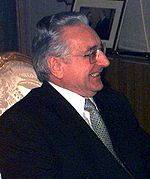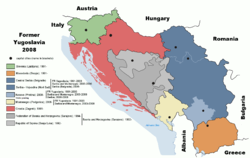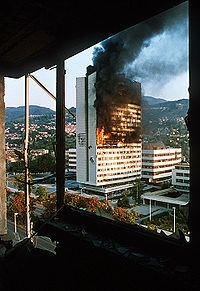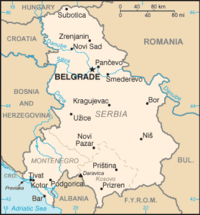- Breakup of Yugoslavia
-
This article is about the events entailing the destruction of the Yugoslav state. For the military conflicts resulting from the dissolution of Yugoslavia, see Yugoslav Wars.
Breakup of Yugoslavia 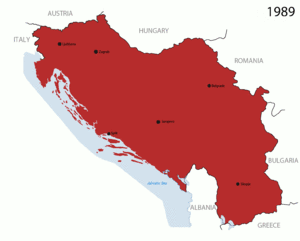
An animated series of maps showing the breakup of SFR Yugoslavia through 1992. The different colors represent the areas of control. Yugoslavia (1943-1992) Croatia (1991-) Croatian Republic of Herzeg-Bosnia (1992-1994) Serbia and Montenegro (1992-2006) Republika Srpska (1992-) Republic of Serbian Krajina (1991-1995) Republic of Bosnia and Herzegovina (1992-1998) Macedonia (1991-) Slovenia (1991-)Participants Slobodan Milošević, Franjo Tuđman, Alija Izetbegović, Radovan Karadžić Location Yugoslavia Date 1989-1992 Result Dissolution of the Yugoslav state, five new states emerge. The Breakup of Yugoslavia refers to a series of conflicts and political upheavals resulting in the dissolution of Yugoslavia (the Socialist Federal Republic of Yugoslavia, SFR Yugoslavia, or simply SFRY). The SFR Yugoslavia was a country that occupied a strip of land stretching from Central Europe to the Balkans – a region with a history of ethnic conflict. The country was a conglomeration of six regional republics and two autonomous provinces that was roughly divided on ethnic lines and split up in the 1990s into several independent countries. These eight federal units were the six republics: Slovenia, Croatia, Bosnia and Herzegovina, Macedonia, Montenegro, Serbia, and two autonomous provinces within Serbia: Kosovo and Vojvodina.
With Bosnia's demographic structure comprising a population of Serbs and Croats making close to 50%, and with ideas on independence resting with the ethnicities rather than the nation on the whole, control of territory once again became open to interpretation, with large sections of Bosnia, Croatia and Serbia under dispute as to its proper ownership. The most important elements which fostered the discord are the formation of the Kingdom of Yugoslavia, the civil war and genocide (see Jasenovac concentration camp) by the Independent State of Croatia during the Second World War, the overreaching idea of "Greater Serbia", and the Balkan adaptations of Pan-Slavism.
Causes
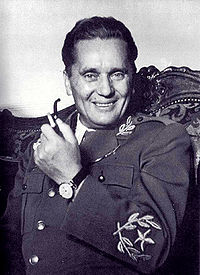 Marshal Josip Broz Tito, Yugoslav President (1953–1980), and Prime Minister (1945–1963)
Marshal Josip Broz Tito, Yugoslav President (1953–1980), and Prime Minister (1945–1963)
Economic collapse and the international climate
Yugoslavia was once a regional industrial power and economic success. From 1960 to 1980, annual gross domestic product (GDP) growth averaged 6.1 percent, medical care was free, literacy was 91 percent, and life expectancy was 72 years.[1] But after a decade of Western economic ministrations and five years of disintegration, war, boycott, and embargo, the economy of Yugoslavia collapsed.
Yugoslavia was a unique state, straddling both the East and West. Moreover its president, Josip Broz Tito, was one of the fundamental founders of the "third world" or "group of 77" which acted as an alternative to the superpowers. More importantly, Yugoslavia acted as a buffer state between the West and the Soviet Union and also prevented the USSR from getting a toehold on the Mediterranean Sea.
However, after the death of Tito with the rise of Mikhail Gorbachev, perestroika and glasnost in the Soviet Union, the West felt secure enough in the USSR’s intentions that Yugoslavia was no longer of pivotal strategic importance. Despite Belgrade's non-alignment and its extensive trading relations with the European Community and the US, the Reagan administration specifically targeted the Yugoslav economy in a Secret Sensitive 1984 National Security Decision Directive (NSDD 133), "U.S. Policy towards Yugoslavia." A censored version declassified in 1990 elaborated on NSDD 54 on Eastern Europe, issued in 1982.[2] The latter advocated "expanded efforts to promote a 'quiet revolution' to overthrow Communist governments and parties," while reintegrating the countries of Eastern Europe into a market-oriented economy.[3]
The external status quo, which the Communist Party had depended upon to remain viable was thus beginning to disappear. Furthermore, the failure of communism all over Central and Eastern Europe once again brought Yugoslavia’s inner contradictions, economic inefficiencies (such as chronic lack of productivity, fuelled by the country's leaderships' decision to enforce a policy of full employment), and ethno-religious tensions to the surface. Yugoslavia's non-aligned status resulted in access to loans from both superpower blocs. This contact with the United States and the West opened up Yugoslavia’s markets sooner than the rest of Central and Eastern Europe.
The 1973 oil crisis coupled with Western trade barriers, dramatically hindered its thirty years of breakneck economic growth. In order to counter this, Yugoslavia took on a number of International Monetary Fund (IMF) loans and subsequently fell into heavy IMF debt. As a condition of receiving loans, the IMF demanded the "market liberalization" of Yugoslavia. By 1981, Yugoslavia had incurred $19.9 billion in foreign debt. Another concern was the unemployment rate, at 1 million by 1980. This problem was compounded by the general "unproductiveness of the South," which not only added to Yugoslavia’s economic woes, but also irritated Slovenia and Croatia further. A decade of frugality resulted in growing frustration and resentment against both the Serbian 'ruling class,' and the minorities who were seen to benefit from government legislation. Real earnings in Yugoslavia fell by 25% from 1979 to 1985. By 1988 emigrant remittances to Yugoslavia totalled over $4.5 billion (USD), and by 1989 remittances were $6.2 billion (USD), making up over 19% of the world's total.[4][5]
Structural problems
Tito’s Yugoslavia was characterised by constant reforms which failed to resolve key national problems. Moreover, the federal system, due to increasing national tensions, and the Communist Party’s wish to support "national self determination" began to loosen its control. This resulted in the creation of Kosovo, an autonomous region of Serbia, legislated by the 1974 constitution. This constitution broke down powers between the capital and the newly created autonomous regions in Vojvodina (an area of Yugoslavia with a large number of ethnic minorities) and Kosovo (with a large ethnic-Albanian population). This not only exacerbated Serbian fears of a "weak Serbia, for a strong Yugoslavia" but also hit at the heart of Serbian national sentiment. A majority of Serbs see Kosovo as the "cradle of the nation," and would not accept the possibility of losing it to the majority Albanian population.
Kosovo's special significance was due to the defeat of Duke Lazar Hrebeljanović. It was said that he was betrayed at the Battle of Kosovo Polje against the invading Ottoman Turks. The devastating defeat was the end of the Serbian kingdom and the beginning of about 500 years of subjugation under the Ottomans (1389–1868). However, the first records of the battle were not created until 100 years after the battle, and then in the form of a poem. The romantic spin given to this episode of history contributed to the sacred and hallowed nature of the region of Kosovo. The significance of Kosovo in the Serbian mindset was very strong.
This loosened version of the federation essentially made Yugoslavia a de facto confederacy, placing pressure upon the legitimacy of the regime and engendering resentment in the richer republics. Slovenia and Croatia, the most developed republics were continually frustrated by their inability to further lift their standard of living as they had to subsidize the development of the poor republics in what they described as an "economic black hole." It highlighted the vast differences in the quality of life in the different republics. Tito’s death created further problems; in an effort to ensure his legacy, Tito’s 1974 constitution established a system of year-long presidencies, on a rotation basis out of the eight leaders of the republics. Such short terms were highly ineffective. Essentially it left a power vacuum which was left open for most of the 1980s, with only Slobodan Milošević taking the reins in 1989.
Nationalism
In 1989, the 600th anniversary of Serbia’s historic defeat at Kosovo Polje, Slobodan Milošević gave a speech to 200,000 Serbs, which made reference to the nation's great historical past. Milošević’s answer to the incompetence of the federal system was to centralize the government. Considering Slovenia and Croatia were looking farther ahead to independence, this was considered unacceptable.
At the Yugoslav conference in late 1989 talks broke down. The leaders could not come to an agreement on how to deal with the rotating presidency. Moreover many members were no longer willing to rescue what they saw as a sunken ship. Croatia and Slovenia declared independence and the Ten-Day War soon broke out in Slovenia in 1991. After a week, the Slovenes were victorious and the breakup of Yugoslavia had begun.
Constitutional dispute and nationalism (1974–1987)
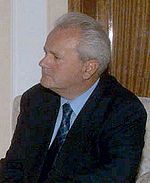 Serbian President Slobodan Milošević's unequivocal desire to uphold the unity of Serbs, a status threatened by each republic breaking away from the federation, in addition to his opposition to the Albanian authorities in Kosovo, further inflamed ethnic tensions.
Serbian President Slobodan Milošević's unequivocal desire to uphold the unity of Serbs, a status threatened by each republic breaking away from the federation, in addition to his opposition to the Albanian authorities in Kosovo, further inflamed ethnic tensions. Croatian President Franjo Tuđman refused to partition Croatia on ethnic lines, which angered the Serb population of Croatia who had wished to remain in union with Serbia-proper. This resulted in the outbreak of violence and war between Croats and Serbs ahead of Croatia's independence.
Croatian President Franjo Tuđman refused to partition Croatia on ethnic lines, which angered the Serb population of Croatia who had wished to remain in union with Serbia-proper. This resulted in the outbreak of violence and war between Croats and Serbs ahead of Croatia's independence.
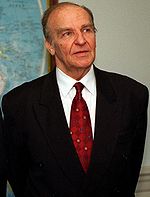 Bosnian President Alija Izetbegović pushed for independence of Bosnia, claiming that he would not allow Bosnia and Herzegovina to become part of what he called "Greater Serbia" which he accused the Serbian government of sponsoring. As head of Bosnia's government, Izetbegović would wage war on three fronts: against Bosnian Serbs, Bosnian Croats and also against a rebel faction of Bosniaks in northern Bosnia led by Fikret Abdić. The Bosnian state he initially wished to build was both against the Serbs' desire for their territory to remain in Yugoslavia, and one which would disenfranchise non-Bosniaks.
Bosnian President Alija Izetbegović pushed for independence of Bosnia, claiming that he would not allow Bosnia and Herzegovina to become part of what he called "Greater Serbia" which he accused the Serbian government of sponsoring. As head of Bosnia's government, Izetbegović would wage war on three fronts: against Bosnian Serbs, Bosnian Croats and also against a rebel faction of Bosniaks in northern Bosnia led by Fikret Abdić. The Bosnian state he initially wished to build was both against the Serbs' desire for their territory to remain in Yugoslavia, and one which would disenfranchise non-Bosniaks.
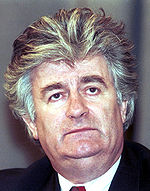 Bosnian Serb President Radovan Karadžić aggressively pursued an agenda to keep Serb territory from being forced to separate from Yugoslavia. The Bosnian Serb army engaged in a war against the ARBiH which would see large numbers of atrocities such as genocide committed by all belligerents. Karadžić is accused of sponsoring many of these incidents. Photo by Mikhail Evstafiev.
Bosnian Serb President Radovan Karadžić aggressively pursued an agenda to keep Serb territory from being forced to separate from Yugoslavia. The Bosnian Serb army engaged in a war against the ARBiH which would see large numbers of atrocities such as genocide committed by all belligerents. Karadžić is accused of sponsoring many of these incidents. Photo by Mikhail Evstafiev. See also: Timeline of Yugoslav breakup
See also: Timeline of Yugoslav breakup1974 Constitution
In 1974, the new Yugoslav constitution was passed. With the 1974 Constitution, the office of President of Yugoslavia was replaced with the Yugoslav Presidency, an eight-member collective head-of-state composed of representatives from six republics and, controversially, two autonomous provinces of the Socialist Republic of Serbia, SAP Kosovo and SAP Vojvodina.
Since the SFR Yugoslav federation was formed in 1945, the constituent Socialist Republic of Serbia (SR Serbia) included the two autonomous provinces of SAP Kosovo and SAP Vojvodina. With the 1974 constitution, the influence of the central government of SR Serbia over the provinces was greatly reduced, which gave them long-sought autonomy. The government of SR Serbia was restricted in making and carrying out decisions that would apply to the provinces. The provinces had a vote in the Yugoslav Presidency (the eight-member collective head-of-state composed of representatives from six republics and the two autonomous provinces), which was not always cast in favor of SR Serbia. In Serbia, there was great resentment towards these developments, which the nationalist elements of the public saw as the "division of Serbia".
Death of Josip Broz Tito
After the death of President Josip Broz Tito on 4 May 1980, ethnic tension grew in Yugoslavia. The death of Tito removed what many Yugoslavs and western observers saw as the country's main unifying force. In 1986, the Serbian Academy of Sciences and Arts (SANU) contributed significantly to the rise of nationalist sentiments, as it drafted the controversial SANU Memorandum protesting against the weakening of the Serbian central government.
The problems in the Serbian autonomous province of SAP Kosovo between ethnic Serbs and Albanians grew exponentially. This, coupled with economic problems in Kosovo and Serbia as a whole, led to even greater Serbian resentment of the 1974 Constitution. In the 1980s, Kosovo Albanians demanded that their autonomous province be granted the status of a constituent republic (which would give SAP Kosovo the right to secede from SFR Yugoslavia). Amid rising tensions, the Serbian general view was that Kosovo as a constituent republic (as opposed to being part of Serbia) would be devastating to the cultural and historic links with Kosovar Serbs and Kosovo in general, especially if the province chose to secede.
Rise of nationalism in SR Serbia (1987–1988)
Slobodan Milošević
In 1987, Serbian communist official Slobodan Milošević was sent to bring calm to an ethnically-driven protest by Serbs against the Albanian administration of SAP Kosovo. Milošević was, up to this point, a hard-line communist who had decried all forms of nationalism as treachery, such as condemning the SANU Memorandum as "nothing else but the darkest nationalism".[6] However, Kosovo's autonomy had always been an unpopular policy in Serbia and Milošević took advantage of the situation and made a departure from traditional communist neutrality on the issue of Kosovo. Milošević assured Serbs that their mistreatment by ethnic Albanians would be stopped. Milošević then began a campaign against the ruling communist elite of SR Serbia, demanding reductions in the autonomy of Kosovo and Vojvodina. These actions made Milošević popular amongst Serbs and aided his rise to power in Serbia. Milošević and his allies took on an aggressive nationalist agenda of reviving SR Serbia within Yugoslavia, promising reforms and protection of all Serbs.
The ruling party of SFR Yugoslavia was the League of Communists of Yugoslavia (SKJ), a composite political party made-up of eight Leagues of Communists from the six republics and two autonomous provinces. The League of Communists of Serbia (SKS) governed SR Serbia. Riding the wave of nationalist sentiment and his new popularity gained in Kosovo, Slobodan Milošević (Chairman of the League of Communists of Serbia (SKS) since May 1986) became the most powerful politician in Serbia by defeating his former mentor President of Serbia Ivan Stambolic at the 8th Session of the League of Communists of Serbia on 22 September 1987. In a 1988 Belgrade rally, Milošević made clear his perception of the situation facing SR Serbia in Yugoslavia, saying:
"At home and abroad, Serbia's enemies are massing against us. We say to them 'We are not afraid'. 'We will not flinch from battle'." Slobodan Milošević, 19 November 1988.[7]
On another occasion, Milošević privately stated:
"We Serbs will act in the interest of Serbia whether we do it in compliance with the constitution or not, whether we do it in compliance in the law or not, whether we do it in compliance with party statutes or not." Slobodan Milošević[8]
Anti-bureaucratic revolution
See also: Anti-bureaucratic revolutionThrough a series of revolts in Serbia and Montenegro, dubbed the "Anti-bureaucratic revolution", Milošević's political allies in SAP Vojvodina, SAP Kosovo, and the Socialist Republic of Montenegro (SR Montenegro) came to power. In addition to Serbia itself, Milošević could now install representatives of the two provinces and SR Montenegro in the Yugoslav Presidency Council. The very instrument that reduced Serbian influence before was now used to increase it: in the eight member Presidency, Milošević could count on a minimum of four votes – SR Montenegro (following local events), his own through SR Serbia, and now SAP Vojvodina and SAP Kosovo as well.
As a result of these events, the ethnic Albanian miners in Kosovo organized strikes, demanding the reinstatement of their autonomy. This contributed to ethnic conflict between the Albanians and the Serb population of the province. At 77% of the population of Kosovo in the 1980s,[9] ethnic-Albanians were the majority. The number of Serbs in Kosovo fell throughout the entire century as a result of ethnic cleansing by Albanians during the Second World War and subsequent harassment by the Albanian authorities and population.[10] The ever increasing ethnic tensions were directly proportional to the trend, and by 1999, Serbs formed as little as 10% of the total population. However, this view is often disputed: historiographers such as Misha Glenny in his book The Balkans, note that the Serbs leaving Kosovo left not due to persecution, but rather for economic reasons, citing Serbs leaving Kosovo after the abolition of Kosovar autonomy. It was easier for Kosovo's Serbs to find jobs in Serbia than Kosovo's Albanians. This resulted in the Kosovo Albanians taking over jobs in Kosovo previously held by Serbs. Albanians also notably have a higher birthrate than Serbs.
Meanwhile the Socialist Republic of Croatia (SR Croatia) and the Socialist Republic of Slovenia (SR Slovenia), supported the Albanian miners and their struggle for recognition. Media in SR Slovenia published articles comparing Milošević to Italian fascist dictator Benito Mussolini. Milošević contended that such criticism was unfounded and amounted to "spreading fear of Serbia".[11] Milošević's state-run media claimed in response that Kučan was endorsing Kosovo and Slovene separatism. Initial strikes in Kosovo turned into widespread demonstrations calling for Kosovo to be made the seventh republic. This angered Serbia's leadership which proceeded to use police force, and later the federal army (the Yugoslav People's Army JNA) by order of the Serbian-controlled Presidency.
Serbian control of the Presidency (1989)
In February 1989 ethnic Albanian Azem Vllasi, SAP Kosovo's representative on the Presidency, was forced to resign and was replaced by an ally of Milošević. Albanian protesters demanded that Vllasi be returned to office, and Vllasi's support for the demonstrations caused Milošević and his allies to respond stating this was a "counter-revolution against Serbia and Yugoslavia", and demanded that the federal Yugoslav government put down the striking Albanians by force. Milošević's aim was aided when a huge protest was formed outside of the Yugoslav parliament in Belgrade by Serb supporters of Milošević who demanded that the Yugoslav military forces enter Kosovo to protect the Serbs there and put down the strike. On 27 February, SR Slovene representative in the collective presidency of Yugoslavia, Milan Kučan, opposed the demands of the Serbs and left Belgrade for SR Slovenia where he attended a meeting in the Cankar Hall in Ljubljana, co-organized with the democratic opposition forces, publicly endorsing the efforts of Albanian protesters who demanded that Vllasi be released. In the 1995 BBC documentary Death of Yugoslavia, Kučan claimed that in 1989, he was concerned that with the successes of Milošević's anti-bureaucratic revolution in Serbia's provinces as well as Montenegro, that his small republic would be the next target for a political coup by Milošević's supporters if the coup in Kosovo went unimpeded. Serbian state-run television denounced Kučan as a separatist, a traitor, and an endorser of Albanian separatism.
Serb protests continued in Belgrade demanding action in Kosovo. Milošević instructed communist representative Petar Gračanin to make sure the protest continued while he discussed matters at the council of the League of Communists, as a means to induce the other members to realize that enormous support was on his side in putting down the Albanian strike in Kosovo. Serbian parliament speaker Borisav Jović, a strong ally of Milošević, met with the current President of the Yugoslav Presidency, Bosnian representative Raif Dizdarević, and demanded that the federal government concede to Serbian demands. Dizdarević argued with Jović saying that "You [Serbian politicians] organized the demonstrations, you control it", Jović refused to take responsibility for the actions of the protesters. Dizdarević then decided to attempt to bring calm to the situation himself by talking with the protesters, by making an impassioned speech for unity of Yugoslavia saying:
"Our fathers died to create Yugoslavia. We will not go down the road to national conflict. We will take the path of Brotherhood and Unity." Raif Dizdarević, 1989.[7]
This statement received polite applause, but the protest continued. Later Jović spoke to the crowds with enthusiasm and told them that Milošević was going to arrive to support their protest. When Milošević arrived, he spoke to the protesters and jubilantly told them that the people of Serbia were winning their fight against the old party bureaucrats. Then a shout to be from the crowd yelled "arrest Vllasi'". Milošević pretended not to hear the demand correctly but declared to the crowd that anyone conspiring against the unity of Yugoslavia would be arrested and punished and the next day, with the party council pushed to submission to Serbia, Yugoslav army forces poured into Kosovo and Vllasi was arrested.
Following the arrest of Vllasi, the group of Kosovo Serb supporters of Milošević who helped bring down Vllasi declared that they were going to Slovenia to hold "the Rally of Truth" which would decry Milan Kučan as a traitor to Yugoslavia and demand his ousting. The Serb protesters were to go by train to Slovenia, but this was stopped when SR Croatia blocked all transit through its territory and stopped the protesters from reaching Slovenia.
Towards secession (1990)
Multi-Party Elections
In January 1990, the extraordinary 14th Congress of the League of Communists of Yugoslavia was convened. The combined Yugoslav ruling party, the League of Communists of Yugoslavia (SKJ), was in crisis. Most of the Congress was spent with the Serbian and Slovene delegations arguing over the future of the League of Communists and Yugoslavia. SR Croatia's actions in preventing Serb protesters from reaching Slovenia played its part. The Serbian delegation, led by Milošević, insisted on a policy of "one person, one vote" in the party membership, which would empower the largest party ethnic group, the Serbs. In turn, the Croats and Slovenes sought to reform Yugoslavia by delegating even more power to six republics, but were voted down continuously in every motion in an attempt to force the party to adopt the new voting system. As a result, the Croatian delegation, led by Chairman Ivica Račan, and Slovene delegation left the Congress on 23 January 1990, effectively dissolving the all-Yugoslav party. This in turn, along with external pressure, caused the adoption of multi-party systems in all republics.
When the individual republics organized their multi-party elections in 1990, the ex-communists mostly failed to win re-election, while most of the elected governments took on nationalist platforms, promising to protect their separate nationalist interests. In multi-party parliamentary elections nationalists defeated re-branded former Communist parties in Slovenia on 8 April 1990, in Croatia on 22 April and 2 May 1990, in Macedonia 11 and 25 November and 9 December 1990, and in Bosnia and Herzegovina on 18 and 25 November 1990. In multi-party parliamentary elections re-branded former communist parties were victorious in Montenegro on 9 and 16 December 1990, and in Serbia on 9 and 23 December 1990. In addition Serbia re-elected Slobodan Milošević as President. Serbia and Montenegro now increasingly favored a Serb-dominated Yugoslavia.
Ethnic tensions in Croatia
In Croatia the nationalist Croatian Democratic Union (HDZ) was elected to power, led by controversial nationalist Franjo Tuđman, under the promise of "protecting Croatia from Milošević". There was growing advocacy for "Croatian state and historical rights" which resulted in the status of ethnic Serbs of Croatia being changed from "constitutional nation" to "national minority". Croatian Serbs, for their part, were wary of Tuđman's nationalist government and in 1990, Serb nationalists in the southern Croatian town of Knin organized and formed a separatist entity known as the SAO Krajina, which demanded to remain in union with the rest of the Serb populations if Croatia decided to secede. The government of Serbia endorsed the Croatian Serbs' rebellion, claiming that for Serbs, rule under Tuđman's government would be equivalent to the World War II fascist Independent State of Croatia (NDH) which committed genocide against Serbs during World War II. Milošević used this to rally Serbs against the Croatian government and Serbian newspapers joined in the warmongering.[12] Serbia had by now printed $1.8 billion worth of new money without any backing of Yugoslav central bank.[13]
Croatian Serbs in Knin, under the leadership of local Knin police inspector Milan Martić, began to try to gain access to weapons so that the Croatian Serbs could mount a successful revolt against the Croatian government. Croatian Serb politicians including the Mayor of Knin met with Borisav Jović, the head of the Yugoslav Presidency in August 1990, and urged him to push the council to take action to prevent Croatia from separating from Yugoslavia, as they claimed that the Serb population would be in danger in Croatia led by Tuđman and his nationalist government. At the meeting, army official Petar Gračanin told the Croatian Serb politicians how to organize their rebellion, telling them to put up barricades, as well as assemble weapons of any sort in which he said "If you can't get anything else, use hunting rifles". Initially the revolt became known as the "Log Revolution" as Serbs blockaded roadways to Knin with cut-down trees and prevented Croats from entering Knin or the Croatian coastal region of Dalmatia. The BBC documentary "Death of Yugoslavia" revealed that at the time, Croatian TV dismissed the "Log Revolution" as the work of drunken Serbs, trying to diminish the serious dispute. However the blockade was damaging to Croatian tourism. The Croatian government refused to negotiate with the Serb separatists and decided to stop the rebellion by force, and sent in armed special forces by helicopters to put down the rebellion. The pilots claimed they were bringing "equipment" to Knin, but the federal Yugoslav Air Force intervened and sent fighter jets to intercept them and demanded that the helicopters return to their base or they would be fired upon, in which the Croatian forces obliged and returned to their base in Zagreb. To the Croatian government, this action by the Yugoslav Air Force revealed to them that the Yugoslav People's Army was increasingly under Serbian control. The SAO Krajina was officially declared as a separate entity on 21 December 1990, by the Serbian National Council headed by Milan Babić.
Following the first multi-party election results, the republics of Slovenia, Croatia and Macedonia proposed transforming Yugoslavia into a loose federation of six republics in the autumn of 1990, however Milošević rejected all such proposals, arguing that like Slovenians and Croats, the Serbs also had a right to self-determination. In a December 1990 referendum in Slovenia, a vast majority (88.5% with a 93.2% turnout)[14] of residents voted for independence.
Secession and War (1991–1992)
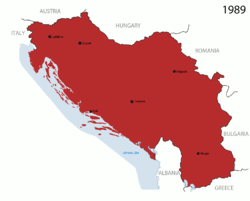 Yugoslav Wars
Yugoslav Wars
Croatia Croatian Republic of Herzeg-Bosnia Serbia and Montenegro Republic of Srpska Republic of Serbian Krajina Republic of Bosnia and Herzegovina Bosnia and Herzegovina Autonomous Province of Western Bosnia Macedonia SloveniaMain article: Yugoslav warsReferendums, Independence, & Recognition
- Slovenia – In the 23 December 1990 referendum 89% voted for independence – which was declared on 25 June 1991.
- Croatia – In the 2 May 1991 referendum 93.24% voted for independence – which was declared on 25 June 1991.
- Macedonia – In the 8 September 1991 referendum 95.26% voted for independence – which was declared on 25 September 1991.
- Bosnia – In the 29 February and 1 March 1992 referendum 92.7% voted for independence – which was declared on 3 March 1992
Slovenia, Croatia, and Bosnia were admitted as member states of the United Nations on 22 May 1992. Macedonia was admitted as a member state of the United Nations on 8 April 1993.
Secession and response
In January 1991, the Kontraobaveštajna služba (KOS, Yugoslav counter-intelligence service) displayed a video of a secret meeting (the "Špegelj Tapes") that they purported had happened some time in 1990 between the Croatian Defence Minister, Martin Špegelj, and two other men, in which Špegelj announced that they were at war with the army and gave instructions about arms smuggling as well as methods of dealing with the Yugoslav Army's officers stationed in Croatian cities. The Army subsequently wanted to indict Špegelj for treason and illegal importation of arms, mainly from Hungary.
The discovery of Croatian arms smuggling combined with the crisis in Knin, the election of independence-leaning governments in Bosnia & Herzegovina, Croatia, Macedonia and Slovenia, and Slovenes demanding independence in the referendum on the issue suggested that Yugoslavia faced the imminent threat of disintegration.
On 12 March 1991 the Yugoslav People's Army (Jugoslovenska Narodna Armija, JNA) met with the Presidency in an attempt to convince them to declare a state of emergency which would allow for the pan-Yugoslav army to take control of the country. Yugoslav army chief Veljko Kadijević declared that there was a conspiracy to destroy the country, saying:
"An insidious plan has been drawn up to destroy Yugoslavia. Stage one is civil war. Stage two is foreign intervention. Then puppet regimes will be set up throughout Yugoslavia." Veljko Kadijević, 12 March 1991.[15]
This statement effectively implied that the new independence-advocating governments of the republics were tools of the west which needed to be removed. Croatian delegate Stjepan Mesić responded angrily to the proposal, accusing Jović and Kadijević of attempting to use the army to create a Greater Serbia and declared "That means war!". Jović and Kadijević then called upon the delegates of each republic to vote on whether to allow martial law, and warned them that Yugoslavia would likely fall apart if martial law was not introduced. In the meeting, a vote was taken on a proposal to enact martial law to allow for military action to end the crisis in Croatia by providing protection for the Serbs. The proposal was rejected by one vote, as the Bosnian Serb delegate, Bogić Bogićević, voted against it, believing that there was still the possibility of diplomacy being able to solve the crisis. The state council was abandoned shortly afterward. After Jović's term as head of the collective presidency expired, he blocked his successor, Mesić, from taking the position, and giving the position instead to Branko Kostić, a member of the pro-Milošević government in Montenegro.
On 19 May 1991, a referendum on the structure of the Yugoslav federation was held in Croatia. Often called the referendum for "independence," the phrasing of the question did not explicitly inquire as to whether one was in favor of secession or not. The referendum asked the voter if he was in favor of Croatia being "able to enter into an alliance of sovereign states with other republics (in accordance with the proposal of the republics of Croatia and Slovenia for solving the state crisis in the SFRY)?". 83.56% of the voters turned out, with Croatian Serbs largely boycotting the referendum. Of these, 94.17% (78.69% of the total voting population) voted "in favor" of the proposal, while 1.2% of those who voted were "opposed".
Both Slovenia and Croatia declared their independence on 25 June 1991. The following day (26 June), the Federal Executive Council specifically ordered the army to take control of the internationally recognized borders of SFR Yugoslavia. The Yugoslav People's Army forces, based in barracks in Slovenia and Croatia, attempted to carry out the task within next 48 hours. However, due to the misinformation given to their own conscripts, and the fact that the majority of them did not wish to engage in a war on their home soil, the Slovenian Territorial Defence forces retook most of the posts within several days with only minimal loss of life on both sides. There was an incident of a suspected war crime near Holmec, as the Austrian ORF TV station showed footage of three Yugoslav Army soldiers surrendering to the Territorial Defence, before gunfire was heard and the troops were seen falling down. However, none were killed in the incident. Ceasefire was agreed upon. On 7 July 1991, the world governments pressured Slovenia and Croatia to place a three-month moratorium on their independence with the Brijuni Agreement (recognized by representatives of all republics). During these three months, the Yugoslav Army completed its pull-out from Slovenia.
Negotiations to restore the Yugoslav federation with diplomat Lord Peter Carington and members of the European Community were all but ended. Carington's plan realized that Yugoslavia was in a state of dissolution and decided that each republic must accept the inevitable independence of the others, along with a promise to Serbian President Milošević that the European Union would insure that Serbs outside of Serbia would be protected. Milošević refused to agree to the plan, as he claimed that the European Community had no right to dissolve Yugoslavia and that the plan was not in the interests of Serbs as it would divide the Serb people into four republics (Serbia, Montenegro, Bosnia & Herzegovina, and Croatia). Carington responded by putting the issue to a vote in which all the other republics, including Montenegro under Momir Bulatović, initially agreed to the plan that would dissolve Yugoslavia. However, after intense pressure from Serbia on Montenegro's President, Montenegro changed its position to oppose the dissolution of Yugoslavia.
Rebellion in Croatia
Yugoslavia 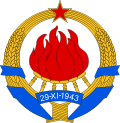
This article is part of the series:
Politics and government of
YugoslaviaExecutiveParliamentElectionsStatesBreakup
At the same time, with the Plitvice Lakes incident of late March/early April 1991, the Croatian War of Independence broke out between the Croatian government and the rebel ethnic Serbs of the SAO Krajina (heavily backed by the by-now Serb-controlled Yugoslav People's Army). On 1 April 1991, the SAO Krajina declared that it would secede from Croatia. Immediately after Croatia's declaration of independence, Croatian Serbs also formed the SAO Western Slavonia and the SAO of Eastern Slavonia, Baranja and Western Srijem. These three regions would combine into the Republic of Serbian Krajina (RSK) on 19 December 1991. The other significant Serb-dominated entities in eastern Croatia announced that they too would join SAO Krajina. Zagreb had by this time discontinued submitting tax money to Belgrade, and the Croatian Serb entities in turn halted paying taxes to Zagreb. In some places, the Yugoslav Army acted as a buffer zone, in others it aided Serbs in their confrontation with the new Croatian army and police forces.
The influence of xenophobia and ethnic hatred in the collapse of Yugoslavia became clear during the war in Croatia. Propaganda by Croatian and Serbian sides spread fear, claiming that the other side would engage in oppression against them and would exaggerate death tolls to increase support from their populations.[16] In the beginning months of the war, the Serb-dominated Yugoslav army and navy deliberately shelled civilian areas of Split and Dubrovnik, a United Nations world heritage site, as well as nearby Croat villages.[17] Yugoslav media claimed that the actions were done due to what they claimed was a presence of fascist Ustaše forces and international terrorists in the city.[17] UN investigations found that no such forces were in Dubrovnik at the time.[18] Croatian military presence increased later on. Montenegrin Prime Minister Milo Đukanović, at the time an ally of Milošević, appealed to Montenegrin nationalism, promising that the capture of Dubrovnik would allow the expansion of Montenegro into the city which he claimed was historically part of Montenegro, and denounced the present borders of Montenegro as being "drawn by the old and poorly educated Bolshevik cartographers".[17] At the same time, the Serbian government contradicted its Montenegrin allies by claims by the Serbian Prime Minister Dragutin Zelenović contended that Dubrovnik was historically Serbian, not Montenegrin.[19] The international media gave immense attention to bombardment of Dubrovnik and claimed this was evidence of Milosevic pursuing the creation of a Greater Serbia as Yugoslavia collapsed, presumably with the aide of the subordinate Montenegrin leadership of Bulatović and Serb nationalists in Montenegro to foster Montenegrin support for the retaking of Dubrovnik.[18]
In Vukovar, ethnic tensions between Croats and Serbs exploded into violence when the Yugoslav army entered the town. The Yugoslav army and Serbian paramilitaries devastated the town in urban warfare and the destruction of Croatian property. Serb paramilitaries committed atrocities against Croats, killing over 200, and displacing others to add to those who fled the town in the Vukovar massacre.[20]
Macedonia and Bosnia
From 1991 to 1992 the situation in the multiethnic Bosnia and Herzegovina grew tense. Its parliament was fragmented on ethnic lines into a majority Bosniak faction and minority Serb and Croat factions. In 1991, the controversial nationalist leader Radovan Karadžić of the largest Serb faction in the parliament, the Serb Democratic Party gave a grave and direct warning to Bosnia's Bosniak president on the fate of Bosnia and its Bosniaks should it decide to separate, saying:
"This, what you are doing, is not good. This is the path that you want to take Bosnia and Herzegovina on, the same highway of hell and death that Slovenia and Croatia went on. Don't think that you won't take Bosnia and Herzegovina into hell, and the Muslim people maybe into extinction. Because the Muslim people cannot defend themselves if there is war here." Radovan Karadžić, 14 October 1991.[21]
In September 1991, Macedonia also declared independence, after a referendum on which 95.26% voted for independence. Five hundred US soldiers were then deployed under the UN banner to monitor Macedonia's northern borders with the Republic of Serbia, Yugoslavia. However, given that Belgrade's authorities had neither intervened to prevent Macedonia's departure, nor protested nor acted against the arrival of the UN troops, the indications were in place that once Belgrade was to form its new country (to be the Federal Republic of Yugoslavia from April 1992), it would recognise the Republic of Macedonia and develop diplomatic relations with it. As such, it became the only former republic to gain sovereignty without resistance from the Belgrade-based Yugoslav authorities and Army. In addition, Macedonia's first president, Kiro Gligorov, did indeed maintain good relations with Belgrade as well as the other former republics and there have to date been no problems between Macedonian and Serbian border police despite the fact that small pockets of Kosovo and the Preševo valley complete the northern reaches of the historical region known as Macedonia, which would otherwise have created a border dispute (see also IMORO).
In November 1991, the Arbitration Commission of the Peace Conference on the former Yugoslavia, led by Robert Badinter, concluded at the request of Lord Carrington that the SFR Yugoslavia was in the process of dissolution, that the Serbian population in Croatia and Bosnia does not have a right to self-determination in form of new states, and that the borders between the republics are to be recognized as international borders. As a result of the conflict, the United Nations Security Council unanimously adopted UN Security Council Resolution 721 on 27 November 1991, which paved the way to the establishment of peacekeeping operations in Yugoslavia.[22]
In the meantime, behind the scenes negotiations began between Milošević and Tuđman to divide Bosnia and Herzegovina into Serb and Croat administered territories to attempt to avert war between Bosnian Croats and Serbs.[23] While, in Bosnia and Herzegovina, Bosnian Serbs held the November 1991 referendum which resulted in an overwhelming vote in favor of staying in a common state with Serbia and Montenegro.
Bosnian Independence and war (1992–1995)
In January 1992, Croatia and Yugoslavia signed an armistice under UN supervision, while Negotiations continued between Serb and Croat leaderships over the partitioning of Bosnia and Herzegovina.[24] In public, pro-state media in Serbia claimed to Bosnians that Bosnia and Herzegovina could be included a new voluntary union within a new Yugoslavia based on democratic government, but this was not taken seriously by Bosnia and Herzegovina's government.[25]
On 9 January 1992, the Bosnian Serb assembly proclaimed a separate Republic of the Serb people of Bosnia and Herzegovina (the soon-to-be Republic of Srpska), and proceeded to form Serbian autonomous regions (SARs) throughout the state. The Serbian referendum on remaining in Yugoslavia and the creation of Serbian autonomous regions (SARs) were proclaimed unconstitutional by the government of Bosnia and Herzegovina. In February–March 1992 the government itself held a national referendum on Bosnian independence from Yugoslavia. That referendum was in turn declared contrary to the BiH and Federal constitution by the federal Constitution court and the newly established Bosnian Serb government; it was also largely boycotted by the Bosnian Serbs. The turnout was somewhere between 64–67% and 98% of the voters voted for independence. It was unclear what the two-thirds majority requirement actually meant and whether it was satisfied. The republic's government declared its independence on 5 April, and the Serbs immediately declared the independence of Republika Srpska. The Bosnian War followed shortly thereafter.
This proved to be the final blow to the pan-Yugoslav Socialist Federal Republic of Yugoslavia. On 28 April 1992, the Serb-dominated Federal Republic of Yugoslavia (FRY) was formed out of the former Socialist Republics of Serbia and Montenegro. Its government claimed continuity to the former country, however, the international community refused to recognize it as such. The stance of the international community was that Yugoslavia had dissolved into its separate states. This question was important for claims on SFRY's international assets, including embassies in many countries. Only in 1996 had the FRY abandoned its claim to continuity from the SFRY. The FRY was dominated by Slobodan Milošević and his political allies.
The war in the western parts of former Yugoslavia ended in 1995 with US-sponsored peace talks in Dayton, Ohio, which resulted in the so-called Dayton Agreement. War between Serbs, Macedonians, and Albanians would continue throughout the 1990s, with the last major conflict being between Albanian nationalists and the government of Republic of Macedonia reduced in violence after 2001.
Kosovo War (1996–1999)
Main article: Kosovo warFinal Breakup (2006–2008)
The rump of the former Communist Yugoslavia was re-named the Federal Republic of Yugoslavia by Serbia and Montenegro on 28 April 1992. The Federal Republic of Yugoslavia was prevented by a UN resolution on 22 September 1992 from continuing to occupy the United Nations seat as successor state to the Socialist Federal Republic of Yugoslavia, and not re-admitted until 1 November 2000 afer an application for membership was submitted as a new country. The country was renamed a second time on 4 February 2003 as the State Union of Serbia and Montenegro.
The State Union of Serbia and Montenegro was itself unstable, and finally broke up during 2006 to 2008 as the last act in the disintegration of Yugoslavia. In a referendum held in Montenegro on 21 May 2006 independence was backed by 55.5% of voters, and independence was declared on 3 June 2006. In Kosovo, which had been administerd by the UN since 1999, a unilateral declaration of independence was made on 17 February 2008. This is not recognized by Serbia, and has limited recognition aross the international community.
See also
- Arbitration Commission of the Peace Conference on the former Yugoslavia
- Socialist Federal Republic of Yugoslavia
- Timeline of Yugoslav breakup
References
- ^ World Bank, World Development Report 1991, Statistical Annex, Tables 1 and 2, 1991.
- ^ NSDD – National Security Decision Directives – Reagan Administration
- ^ Sean Gervasi, 'Germany, the US, and the Yugorlav Crisis,' Covert Action, n. 43, Winter 1992–93, p 42
- ^ Beth J. Asch, Courtland Reichmann, Rand Corporation. Emigration and Its Effects on the Sending Country. Rand Corporation, 1994. (pg. 26)
- ^ Douglas S. Massey, J. Edward Taylor. International Migration: Prospects and Policies in a Global Market. Oxford University Press, 2004. (pg. 159)
- ^ Lampe, John R. 2000. Yugoslavia as History: Twice There Was a Country. Cambridge: Cambridge University Press. p347
- ^ a b Death of Yugoslavia. British Broadcasting Corporation (BBC). 1995.
- ^ Ramet, Sabrina P. 2006. The Three Yugoslavias: State-Building and Legitimation. Indiana University Press. p598.
- ^ Demographics of Kosovo#1968-1989: Autonomy
- ^ Ruza Petrovic; Marina Blagojevic. Milos Macura. ed. The Migration of Serbs and Montenegrins from Kosovo and Metohija. Belgrade: Serbian Academy of Sciences and Arts. ISBN 86-7025-154-X 1. http://www.rastko.org.rs/kosovo/istorija/kosovo_migrations/index.html. Retrieved 7 March 2007.
- ^ Communism O Nationalism!, TIME Magazine, 24 October 1988
- ^ "Roads Sealed as Yugoslav Unrest Mounts". The New York Times. 19 August 1990. http://query.nytimes.com/gst/fullpage.html?res=9C0CE5DC1538F93AA2575BC0A966958260&scp=7&sq=Tudjman&st=nyt. Retrieved 26 April 2010.
- ^ Sudetic, Chuck (10 January 1991). "Financial Scandal Rocks Yugoslavia". The New York Times. http://query.nytimes.com/gst/fullpage.html?res=9D0CE1D81638F933A25752C0A967958260. Retrieved 26 April 2010.
- ^ http://www.sussex.ac.uk/sei/documents/slovenian3.pdf REFERENDUM BRIEFING NO 3
- ^ Death of Yugoslavia. British Broadcasting Corporation (BBC). 1995.
- ^ Icty – Tpiy ::
- ^ a b c Pavlovic: The Siege of Dubrovnik
- ^ a b Pavlovic: The Siege of Dubrovnik
- ^ Pavlovic: The Siege of Dubrovnik
- ^ "Two jailed over Croatia massacre". BBC News. 27 September 2007. http://news.bbc.co.uk/2/hi/europe/7016290.stm. Retrieved 26 April 2010.
- ^ Karadzic and Mladic: The Worlds Most Wanted Men – FOCUS Information Agency
- ^ "Resolution 721". N.A.T.O.. 25 September 1991. http://www.nato.int/ifor/un/u911127a.htm. Retrieved 21 July 2006.
- ^ Lukic, Reneo; Lynch, Allen. 1996. Europe from the Balkans to the Urals. The Distintegration of Yugoslavia and the Soviet Union. Oxford: Oxford University Press, p209
- ^ Lukic, Reneo; Lynch, Allen. p210
- ^ Burg, Steven L; Shoup, Paul S. 1999. The War in Bosnia-Herzegovina: Ethnic Conflict and International Intervention. M.E. Sharpe. p102
Further Reading
- Almond, Mark, Europe’s Backyard War, William Heinemann Ltd, Great Britain, 1994
- et al. Duncan, W. Raymond and Holman, G. Paul, Ethnic Nationalism and Regional Conflict: The Former Soviet Union and Yugoslavia, Westview Press Inc, USA, 1994. ISBN 0-8133-8813-9
- Dragosavljevic, Angelija, Slobodan Milosevic: A Study In Charismatic Leadership And Its Distortions 1987–1992, Australian National University Press, Canberra, 1993
- Glenny, Misha, "The Fall of Yugoslavia", Penguin, 3rd Edition 1996, ISBN 0-14-026101-X
- LeBor, Adam "Milosevic: A Biography", Bloomsbury, 2002, ISBN 0-7475-6181-8
- Magas, Branka, The Destruction of Yugoslavia: Tracking the Break-up 1980–1992, Verso, Great Britain, 1993. ISBN 0-86091-593-X
- Mojzes, Paul, Yugoslavian Inferno: in the Balkans, The Continuum Publishing company, USA, 1994
- Radan, Peter, Break-up of Yugoslavia and International Law, Routledge, Great Britain, 2002
- Woodward, Susan, L. Balkan Tragedy: Chaos & Dissolution after the Cold War, the Brookings Institution Press, Virginia, USA, 1995
Fall of Communism Internal conditions Brezhnev stagnation · Cultural Revolution · Eastern Bloc · Eastern Bloc economies · Eastern Bloc politics · Eastern Bloc information dissemination · Eastern Bloc emigration and defection · KGB · Nomenklatura · Samizdat · Shortage economy · TotalitarianismInternational relations Active measures · Cold War · List of socialist countries · Predictions of Soviet collapse · Reagan Doctrine · Soviet Empire · Terrorism and the Soviet Union · Vatican oppositionReforms of socialism Events by country Eastern Bloc countries: Albania · Bulgaria · Czechoslovakia · East Germany · Hungary · Poland · Romania · Soviet Union · Yugoslavia
Former Soviet Republics: Armenia · Azerbaijan · Belarus · Estonia · Georgia · Latvia · Lithuania · Kazakhstan · Kirghistan · Moldova · Russia · Tajikstan · Turkmenistan · Ukraine · Uzbekistan
Other countries: Afghanistan · Angola · Benin · Burma · Cambodia · China · People's Republic of the Congo · Ethiopia · Mongolia · Mozambique · Nicaragua · Somalia · South YemenCommunist leaders Ramiz Alia · Heydar Aliyev · Yuri Andropov · Aung San · Siad Barre · Leonid Brezhnev · Fidel Castro · Nicolae Ceauşescu · Konstantin Chernenko · Mikhail Gorbachev · Károly Grósz · Hua Guofeng · Erich Honecker · Enver Hoxha · János Kádár · Nikita Khrushchev · Kim Il-sung · Milouš Jakeš · Wojciech Jaruzelski · Mathieu Kérékou · Mengistu Haile Mariam · Slobodan Milošević · Denis Sassou Nguesso · Saparmurat Niyazov · Daniel Ortega · Kaysone Phomvihane · Pol Pot · Tôn Đức Thắng · Phoumi Vongvichit · Ne Win · Deng Xiaoping · Todor ZhivkovAnti-communist leaders Corazon Aquino · Sali Berisha · Willy Brandt · Vladimir Bukovsky · Violeta Chamorro · Chiang Ching-kuo · Viacheslav Chornovil · Tsakhiagiin Elbegdorj · Václav Havel · John F. Kennedy · Helmut Kohl · Vytautas Landsbergis · Pope John Paul II · Zianon Pazniak · Augusto Pinochet · Ronald Reagan · Lee Teng-hui · Margaret Thatcher · Harry S. Truman · Lech Wałęsa · Boris Yeltsin · Zhelyu ZhelevDemocracy movements Chinese democracy movement · Civic Forum · Democratic Party of Albania · Democratic Russia · Sąjūdis · Rukh · Solidarity · Popular Front of Latvia · Popular Front of Estonia · Public Against Violence · Belarusian Popular Front · National League for Democracy · National Opposition Union · United Nationalist Democratic Organization · National Salvation Front · Union of Democratic ForcesEvents People Power Revolution · Revolutions of 1989 · April 9 tragedy · Black January · Baltic Way · 1988 Polish strikes · Tiananmen Square protests of 1989 · Removal of Hungary's border fence · Polish Round Table Talks · Hungarian Round Table Talks · Pan-European Picnic · Monday demonstrations in East Germany · Fall of the Berlin Wall · Malta Summit · German reunification · January 1991 events in Lithuania · January 1991 events in Latvia · 1991 Soviet coup d'état attempt · Yemeni unification · Chilean transition to democracyPost-collapse Colour revolution · Decommunization · Democratization · Economic liberalization · Economic reforms after the collapse of socialism · Neo-Stalinism · North Korean famine · Oslo Accords · Post-communism · Putinism · Special Period · Yugoslav WarsTimeline of Yugoslav statehood Timeline Prior to 1918 Creation
1918 – 1941World War II
1938 – 1945Socialist Yugoslavia
1943 – 1992Breakup & Yugoslav Wars
1990 –Slovenia territories controlled by Austria-Hungary
(1867 – 1918)
Included Bay of Kotor
See also:
Kingdom of Croatia-Slavonia
(1868 – 1918)
Kingdom of Dalmatia
(1815 – 1918)
Condominium of BIH
(1878 – 1918)Kingdom of Serbs, Croats and Slovenes
(1918 – 1929)
↓ renamed ↓
Kingdom of Yugoslavia
(1929 – 1943)
See also:
State of Slovenes, Croats and Serbs
(1918)
Banat, Bačka and Baranja (1918-1919)
Free State of Fiume
(Free 1920 – 1924;
Italy 1924 – 1947)annexed by Fascist Italy and Nazi Germany
(1941 – 1943/1945)
Prekmurje annexed by HungaryDemocratic Federal Yugoslavia
(DFY, 1943 – 1946)
↓ renamed ↓
Federal People's Republic of Yugoslavia
(FPRY, 1946 – 1963)
↓ renamed ↓
Socialist Federal Republic of Yugoslavia
(SFRY, 1963 – 1992)
Constituent federal subjects to the rightSR Slovenia
(1944 – 1991)Republic of Slovenia
(since 1991; see Ten-Day War)Dalmatia Independent State of Croatia
(1941 – 1945)
puppet of Nazi Germany, parts annexed by Fascist Italy
Međimurje and Baranja annexed by HungarySR Croatia
(1943 – 1991)Republic of Croatia
(since 1991; see Croatian War of Independence)
See also:
SAO Kninska Krajina (1990) → SAO Krajina (1990 – 1991)
SAO Western Slavonia (1990 – 1991)
SAO Eastern Slavonia, Baranja and Western Syrmia (1990 – 1991)
↳ Republic of Serbian Krajina ↲ (1990 – 1995)Slavonia Croatia Bosnia SR Bosnia and Herzegovina
(1943 – 1992)Bosnia and Herzegovina
(since 1992; see Bosnian War); Consists of:
Federation of Bosnia and Herzegovina (since 1995)
Republika Srpska (since 1995)
Brčko District (since 2000)
See also: Republic of Bosnia and Herzegovina, Croatian Republic of Herzeg-Bosnia
SAO Bosanska Krajina, SAO North-Eastern Bosnia, SAO Romanija, SAO Herzegovina (1991 – 1992)
↳ Serbian Republic of Bosnia and Herzegovina ↲ (1992 – 1995)Herzegovina Vojvodina Autonomous Banat (formally part of Nedić's Serbia)
Bačka annexed by Hungary (1941 – 1944)
Syrmia annexed by Independent State of Croatia (1941 – 1944)SR Serbia
(1943 – 1990)
Included APs:
SAP Vojvodina &
SAP KosovoFederal Republic of Yugoslavia
(1992 – 2003)
↓ renamed ↓
State Union of Serbia and Montenegro
(2003 – 2006)
Consisted of until 2006:
Republic of Serbia (1990)
Republic of Montenegro (1992)
See also:
Republic of Kosova
(1990 – 2000)Republic of Serbia
(2006 – 2008)
Included APs:
Vojvodina &
Kosovo and Metohija
(under UN administration)Republic of Serbia
(since 2006)
Includes AP VojvodinaSerbia Kingdom of Serbia
(1882 – 1918)Nedić's Serbia
(1941 – 1944)
puppet of Nazi Germany
See also: Republic of UžiceKosovo Kingdom of Serbia
(1912 – 1918)mostly annexed by Albania
(1941 – 1944)
along with western Macedonia and south-eastern MontenegroRepublic of Kosovo
(since 2008)
Declared unilateral independence, which is since then only partially recognisedMetohija Kingdom of Montenegro
(1910 – 1918)
Metohija controlled by Austria-Hungary
(1915 – 1918)Montenegro Protectorate annexed by Fascist Italy (1941 – 1943) and Nazi Germany
(1943 – 1944)
Smaller part annexed by Independent State of Croatia (1941 – 1944)SR Montenegro
(1943 – 1992)Montenegro
(since 2006)Macedonia Kingdom of Serbia
(1912 – 1918)annexed by Kingdom of Bulgaria
(1941 – 1944)SR Macedonia
(1944 – 1991)Republic of Macedonia
(since 1991)Categories:- History of Yugoslavia
- Dissolutions of countries
Wikimedia Foundation. 2010.

